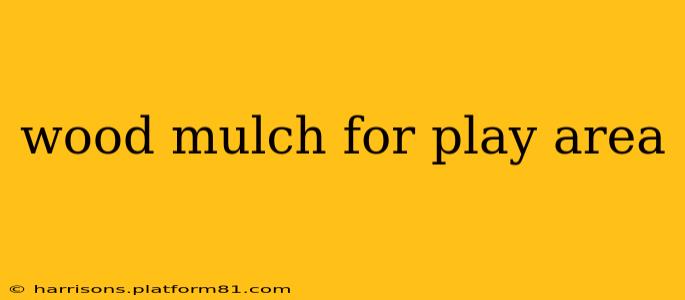Wood mulch is a popular choice for landscaping, and its use in play areas is widespread. However, choosing the right type of wood mulch and understanding its potential risks is crucial for ensuring a safe and enjoyable play environment for children. This comprehensive guide will delve into the specifics of using wood mulch in play areas, addressing common concerns and offering expert advice.
What are the Benefits of Using Wood Mulch in Play Areas?
Wood mulch offers numerous benefits, making it a desirable option for playgrounds and other play areas. Its soft, cushioning surface helps to reduce the impact of falls, minimizing the risk of injuries. It also provides a natural and aesthetically pleasing look, enhancing the overall appeal of the play space. Furthermore, wood mulch helps to suppress weeds, retains soil moisture, and moderates soil temperature, contributing to a healthy and thriving play area environment. Finally, it's relatively inexpensive compared to other surfacing materials.
What Types of Wood Mulch are Suitable for Play Areas?
Not all wood mulch is created equal. When choosing wood mulch for a play area, it's essential to select a product specifically treated for this purpose. Avoid using recycled wood mulch or mulch from unknown sources. These may contain harmful chemicals or treated lumber fragments. Look for play-safe certified wood mulch, indicating it's been tested and meets safety standards regarding harmful substances like arsenic and chromium. Cedar and redwood are popular choices due to their natural pest-repelling properties, but ensure they are sourced and treated responsibly.
Is Wood Mulch Safe for Children?
While wood mulch offers many advantages, safety concerns are paramount. The primary concern revolves around potential hazards like splinters and the possibility of harmful chemicals. Using properly treated and play-safe certified wood mulch significantly mitigates these risks. Regular inspection and maintenance are crucial. Remove any large chunks of wood, debris, or anything that could pose a safety hazard. Regularly replenish the mulch to maintain a sufficient depth for cushioning and weed suppression.
What are the potential dangers of wood mulch in a play area?
The potential dangers of wood mulch stem primarily from the type of wood used and its treatment. Untreated wood mulch may contain harmful chemicals, while even treated mulch can pose a risk of splinters if not properly maintained. Additionally, standing water in thick mulch can become a breeding ground for mosquitoes.
How deep should wood mulch be in a play area?
The recommended depth for wood mulch in a play area is typically 6 to 12 inches. This depth provides adequate cushioning to lessen the impact of falls while preventing weed growth. Always consult local safety regulations and guidelines for specific depth requirements.
How often should I replace wood mulch in a play area?
Replacing wood mulch annually, or at least every two years, is generally recommended. This prevents the buildup of harmful substances and ensures continued effectiveness in cushioning and weed suppression. However, the frequency may need adjustment depending on use, weather conditions, and the rate of decomposition.
How do I maintain wood mulch in a play area to ensure safety?
Maintaining wood mulch involves regular inspections for debris, large wood pieces, and any potential hazards. Removing these items promptly ensures a safe play environment. Regular raking to even out the surface and address compaction also keeps the mulch effective as a safety surface.
Alternatives to Wood Mulch for Play Areas
While wood mulch remains a popular option, alternatives exist for those seeking different properties or seeking to completely avoid wood-based materials. Rubber mulch is a common alternative, offering excellent impact absorption and durability. Pea gravel can also be used but requires careful consideration of size and potential for injury. Other options, like engineered wood fiber, offer similar cushioning properties but with enhanced durability.
In conclusion, selecting and maintaining wood mulch correctly creates a safe and engaging play area for children. Prioritizing safety, choosing the right type of mulch, and implementing regular maintenance ensures a positive and enjoyable experience for everyone. Always prioritize safety and consult with local regulations and safety guidelines to guarantee compliance with all safety standards.
